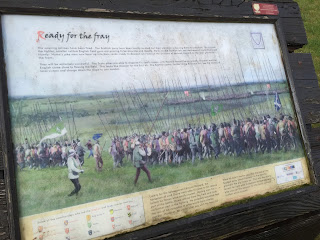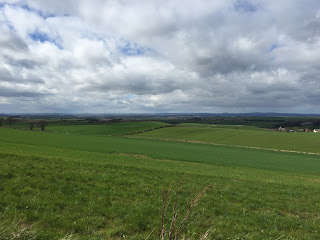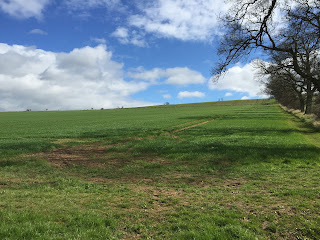What an opener - The shot below was taken on April 17th 2016 on the forward (north facing) slope of Branxton Hill, Northumberland and it looks towards the positions occupied by Sir Edmund Howard's men on the rise above the display board. Beyond that hill is the River Tweed and the full panorama in the distance is the Kingdom of Scotland. On September 9th 1513 the nobility of Scotland perished in drove at this very spot.
 |
| The army can see home but has to fight to reach it |
On our way back from SALUTE 2016 the battlefield walkers Toggy and Barry visited Flodden Field, scene of perhaps the most emotive battle in Scottish history. For me personally it is more important than Bannockburn or Culloden. On the ground before your eyes over 10,000 of my countrymen died in a most terrible way, drowning in mud and cut to pieces by their opponents.
Toggy knew little about Flodden and it was a joy to explore the field together, march the route of the Scottish divisions down into the low ground and feel the history of the place.
 |
| Intelligently positioned display boards support the walker's understanding |
Having first espied the English positions from the spot where King James IV's division descended the steep slope of Branxton Hill on a drizzly autumn day, we commenced our walk across the face of the Scot's positions to the extreme western edge where stood Hume and his contingent.
 |
| The view from the Scottish left looking north towards the English line. |
Toggy and I descended the hill without pike and in warm modern clothes and good walking shoes. We both slithered and stumbled down the slope, each of us in turn almost falling on our tails as the mud gave underfoot.
 |
| Looking north at the English centre now the site of Branxton village. |
We took perhaps five minutes to negotiate the slope but the Scots Army had began at the top of the hill whilst we joined the trail half way down. This means the descent may have taken 10 - 15 minutes or more on the day of the battle.
 |
|
Looking to the dry ground on which Hume vanquished the English right
|
On reaching 'soggy bottom' the now drained bog, invisible to the Scots until they walked into it, Toggy and I appreciated the dilemma which faced the massed pike blocks. Wet, muddy, disordered, stuck in bog and being pressed from behind by thousands of their comrades, cohesion was lost. The English billmen on a significant rise to their front would have goaded them with missiles, cannon fire and insults. The few who struggled out of the bog with their long pikes were easy prey to the more agile billmen who cut them down.
At the lowest level of the battlefield is an interesting geological chart showing the prevalent ground conditions. Fascinating stuff.
 |
| Geology lesson |
Turning around Tog and I looked back up the slope which we had descended. Those tree tops way in the distance mark the gun line of the massive and unwieldy Scottish artillery which found it so difficult to depress their muzzles to the appropriate angle to be effective.
 |
|
The Scots guns were way back up there beside those distant tree tops
|
In the second part of the tragedy of Flodden we'll share more shots, describe how victory turned to defeat and explain the total destruction of the Scottish Army.
 |
|
No your Majesty! Stop! it is hell down here in the mud!
|
